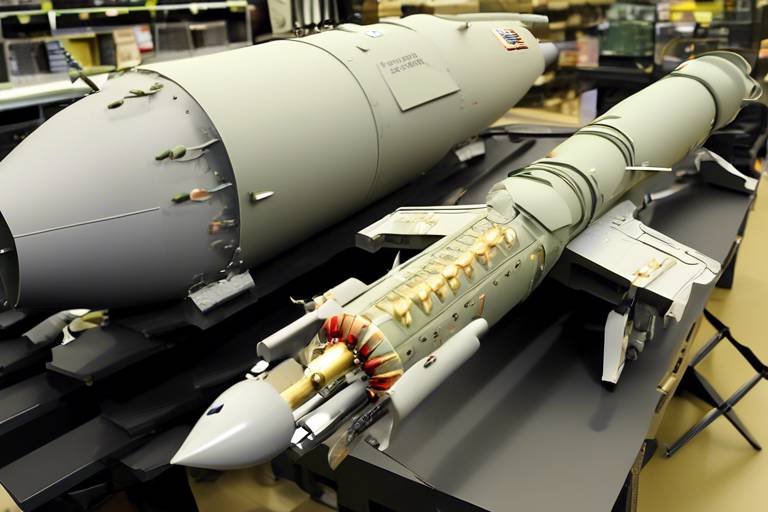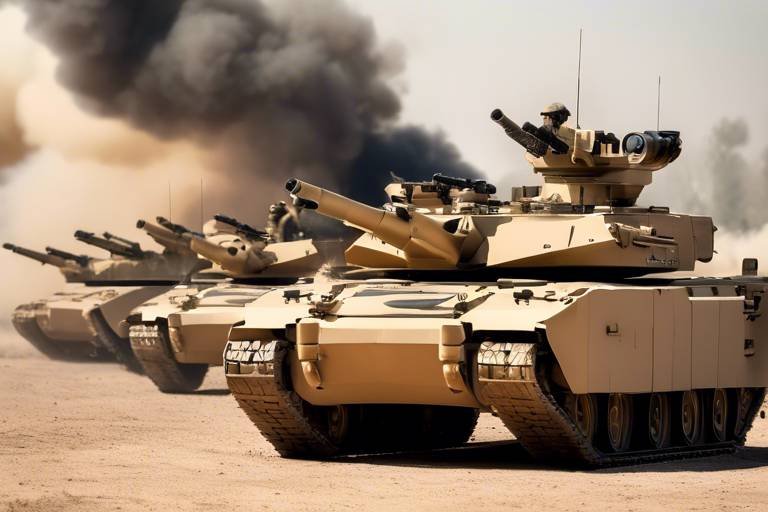The Development of the Joint Direct Attack Munition (JDAM)
The Joint Direct Attack Munition (JDAM) represents a significant leap in the evolution of military weaponry, particularly in the realm of precision-guided munitions. Developed during a time when the need for accuracy in combat was paramount, the JDAM has transformed the landscape of modern warfare. Imagine a world where airstrikes could be executed with surgical precision, minimizing collateral damage while maximizing effectiveness. This is precisely what JDAM has brought to the table. But how did we get here?
The journey of JDAM began in the late 1980s, a period marked by rapid advancements in technology and a changing global military landscape. The Gulf War served as a catalyst for its development, highlighting the necessity for more accurate bombing capabilities. Traditional bombs, while powerful, often resulted in significant unintended damage and civilian casualties. The military recognized that a shift was needed—one that would not only enhance the accuracy of airstrikes but also align with the evolving principles of warfare that prioritize minimizing harm to non-combatants.
In response to these pressing needs, the JDAM was developed as a conversion kit that could be attached to existing unguided bombs. This innovative approach allowed for rapid deployment and integration into the existing arsenal, providing a cost-effective solution to the challenges faced in modern combat. The core of the JDAM's technology lies in its advanced guidance systems, which we will explore in detail later. But first, let's delve deeper into the historical context that shaped its creation.
As military operations evolved, so too did the technology that supported them. The lessons learned from the Gulf War were invaluable, revealing the critical importance of precision in air operations. The JDAM was designed not just as a weapon, but as a solution to the complex challenges of modern warfare. It embodies the shift from brute force to a more calculated approach, where every bomb dropped is a carefully considered decision aimed at achieving strategic objectives without unnecessary collateral damage.
In summary, the development of the JDAM is a story of innovation driven by necessity. It reflects a broader transformation in military strategy, where the emphasis has shifted towards precision and efficiency. As we move forward in this article, we will uncover the intricate technical specifications that make JDAM a preferred choice for air forces around the globe. Buckle up, because the journey through the world of JDAM technology is just beginning!
- What is JDAM? - JDAM stands for Joint Direct Attack Munition, a precision-guided bomb that enhances the accuracy of unguided bombs through advanced guidance systems.
- When was JDAM developed? - JDAM was developed in the late 1980s and gained prominence during the Gulf War in the early 1990s.
- How does JDAM improve targeting accuracy? - JDAM utilizes a combination of GPS and inertial navigation systems to provide real-time updates and maintain trajectory, ensuring high accuracy even in challenging conditions.
- What are the benefits of using JDAM in military operations? - JDAM minimizes collateral damage, allows for flexibility in mission planning, and enhances the effectiveness of airstrikes.
Historical Background
The development of the Joint Direct Attack Munition (JDAM) can be traced back to the evolving needs of modern warfare, particularly highlighted during the Gulf War in the early 1990s. The military recognized that traditional unguided bombs, often referred to as "dumb bombs," were becoming increasingly ineffective in a landscape where precision was paramount. As technology advanced, the demand for a weapon that could deliver pinpoint accuracy while minimizing collateral damage became a pressing necessity.
In the heat of the Gulf War, the U.S. military faced a challenging environment where conventional bombing tactics often resulted in unintended civilian casualties and damage to critical infrastructure. This realization sparked a revolution in military munitions. The JDAM program was initiated to transform standard bombs into precision-guided munitions by incorporating advanced guidance systems. The goal was to create a versatile weapon that could be deployed in various combat scenarios, adapting to the rapidly changing dynamics of warfare.
By the late 1990s, the JDAM was officially introduced and began to see operational use. Its development was not just a technological leap but also a strategic shift in military doctrine. The ability to strike with precision meant that military planners could engage targets with greater confidence, knowing that the risk of collateral damage would be significantly reduced. This shift was crucial in subsequent conflicts, where the emphasis on minimizing civilian casualties became a moral and operational imperative.
Moreover, the success of JDAM in various military operations has led to its adoption by numerous countries around the globe. As nations recognize the importance of precision in modern warfare, the JDAM has become a staple in air forces worldwide, reflecting a broader trend towards integrating advanced technology into military capabilities. The evolution of JDAM not only underscores the importance of technological innovation in warfare but also highlights the ongoing need for military forces to adapt to new challenges on the battlefield.
In summary, the historical background of JDAM is rooted in a combination of technological advancements and the pressing need for precision in military operations. Its development has significantly influenced modern military strategy and operational effectiveness, marking a pivotal moment in the evolution of aerial warfare.
Technical Specifications
The Joint Direct Attack Munition (JDAM) represents a significant leap in military technology, merging traditional bomb designs with cutting-edge guidance systems. At its core, the JDAM is a conversion kit that transforms unguided bombs into precision-guided munitions. This transformation is primarily achieved through the integration of advanced guidance systems, making it a game-changer in modern warfare. The JDAM is designed to enhance the accuracy and effectiveness of airstrikes, allowing military forces to engage targets with remarkable precision.
One of the standout features of the JDAM is its guidance system, which combines inertial navigation and Global Positioning System (GPS) technology. This combination allows the munition to accurately strike targets even in adverse weather conditions and challenging terrains. The JDAM can maintain its trajectory and accuracy, ensuring that it hits its intended target with minimal collateral damage. This capability is crucial in modern combat, where minimizing civilian casualties is a top priority.
The dual guidance system of the JDAM is what sets it apart from traditional bombs. The inertial navigation system (INS) provides the munition with a reliable means of maintaining its flight path. This system calculates the bomb's position based on its speed and direction, allowing it to continue its trajectory even when GPS signals are weak or unavailable. On the other hand, the GPS component allows for real-time updates, enabling the JDAM to adjust its course and strike moving targets effectively. This integration of technologies results in a weapon that is not only precise but also adaptable to the dynamic nature of the battlefield.
The integration of GPS technology into the JDAM is revolutionary. It allows the munition to receive real-time data, which enhances its ability to hit moving targets. Imagine trying to hit a moving target with a bow and arrow; the key is to anticipate where the target will be when the arrow arrives. Similarly, the JDAM uses GPS to adjust its flight path dynamically, ensuring that it can strike fast-moving vehicles or enemy combatants with pinpoint accuracy. This capability dramatically increases the munition's effectiveness in combat scenarios where speed and precision are paramount.
Inertial navigation is another critical component of the JDAM's technical specifications. This system allows the munition to maintain its trajectory even in the absence of GPS signals, which can be disrupted by various factors such as jamming or environmental conditions. Think of it as a compass guiding a ship through a storm. The JDAM's inertial navigation system ensures that it stays on course, providing reliability in diverse operational scenarios. This feature is particularly vital during missions where GPS signals may be compromised, allowing military forces to trust that their munitions will still hit their intended targets.
The versatility of the JDAM extends to its payload options as well. It can be equipped with various warheads, tailored to meet the specific needs of a mission. This flexibility allows military planners to choose the appropriate warhead based on the target's nature and the desired effects. For instance, a JDAM can be fitted with a high-explosive warhead for maximum destruction or a smaller warhead for precision strikes in urban environments. This adaptability makes the JDAM an invaluable asset in modern military operations, allowing forces to respond effectively to a wide range of threats.
| Feature | Description |
|---|---|
| Guidance System | Combination of Inertial Navigation and GPS for precision targeting. |
| Payload Options | Various warheads available for mission-specific needs. |
| Operational Range | Effective at ranges exceeding 15 nautical miles. |
| Weight | Typically weighs between 500 and 2,000 pounds depending on the warhead. |
Guidance Systems
The Joint Direct Attack Munition (JDAM) is a marvel of modern military engineering, particularly when it comes to its . At the heart of the JDAM's effectiveness lies a sophisticated integration of inertial navigation and Global Positioning System (GPS)
One of the standout features of the JDAM's guidance system is its ability to operate effectively in various weather conditions and terrains. The inertial navigation system allows the munition to maintain its trajectory even when GPS signals are weak or unavailable. This capability is akin to a skilled sailor navigating through fog; they rely on their instruments and knowledge of the sea to stay on course. Similarly, the JDAM can continue its mission without being solely dependent on GPS, making it a reliable choice for military operations.
To further illustrate the JDAM's guidance capabilities, let’s break down the two primary components:
| Component | Description |
|---|---|
| GPS Technology | Enables real-time updates and enhances targeting accuracy, even for moving targets. |
| Inertial Navigation | Maintains trajectory and accuracy in the absence of GPS signals, ensuring reliability. |
In essence, the JDAM’s guidance systems are designed to adapt and respond to the ever-changing dynamics of warfare. This adaptability not only maximizes the munition's effectiveness but also minimizes the risk of collateral damage, a significant concern in modern military operations. With the ability to strike precisely where intended, the JDAM has transformed the way military forces approach airstrikes, making them more surgical and less destructive than traditional bombing methods.
As we delve deeper into the operational use of JDAM, it becomes clear that the technology behind its guidance systems is not just about hitting a target; it's about redefining what it means to engage in conflict in a responsible and effective manner.
- What is JDAM? JDAM stands for Joint Direct Attack Munition, a precision-guided weapon that enhances the accuracy of conventional bombs.
- How does JDAM achieve precision? JDAM combines inertial navigation with GPS technology to maintain accuracy in targeting.
- Can JDAM be used in bad weather? Yes, its inertial navigation system allows it to operate effectively even when GPS signals are compromised.
- What are the benefits of using JDAM in combat? JDAM minimizes collateral damage while achieving strategic objectives, making it a vital asset in modern warfare.
GPS Technology
The integration of into the Joint Direct Attack Munition (JDAM) has revolutionized the way modern warfare is conducted. Imagine being able to pinpoint a target with the precision of a surgeon, even in the chaos of battle. That’s what GPS brings to the table. With its ability to provide real-time location data, JDAM can adjust its flight path dynamically, ensuring it strikes with unmatched accuracy.
One of the most remarkable features of JDAM's GPS technology is its capability to track moving targets. This is particularly crucial in modern combat scenarios where enemy positions are not static. For instance, if a target is on the move, the JDAM can receive updates and adjust its trajectory accordingly. This level of adaptability was unheard of before the advent of GPS-guided munitions.
Moreover, the GPS system in JDAM is not just about hitting a target; it’s about doing so while minimizing collateral damage. In today’s warfare, where civilian lives are often at stake, the ability to strike with precision is paramount. JDAM’s GPS technology allows military forces to engage targets effectively without causing unnecessary harm to surrounding areas. This capability is a game-changer, transforming airstrikes from indiscriminate bombardments into precise surgical strikes.
To further illustrate the importance of GPS in JDAM, consider the following advantages:
- Real-time updates: JDAM can receive GPS signals that inform it of the target's location, allowing for adjustments mid-flight.
- Enhanced accuracy: The use of GPS drastically reduces the Circular Error Probable (CEP), which is the radius within which a weapon is expected to hit.
- Operational flexibility: GPS-guided munitions can be deployed in various environments, including adverse weather conditions, where traditional targeting methods might fail.
In summary, the incorporation of GPS technology into JDAM not only enhances its effectiveness but also aligns with modern military strategies that prioritize precision and minimal collateral damage. This technological leap has made JDAM a cornerstone of contemporary air combat, showcasing how innovation can lead to more humane and effective warfare tactics.
- What is JDAM?
JDAM stands for Joint Direct Attack Munition, a precision-guided bomb that uses GPS technology for enhanced targeting accuracy.
- How does GPS improve JDAM's effectiveness?
GPS allows JDAM to track moving targets and adjust its flight path in real-time, significantly increasing accuracy and reducing collateral damage.
- Can JDAM be used in bad weather?
Yes, the GPS technology in JDAM enables it to operate effectively in various weather conditions, making it a versatile weapon.
Inertial Navigation
Inertial navigation is a crucial component of the Joint Direct Attack Munition (JDAM), enabling it to maintain its trajectory with remarkable precision. Unlike systems that rely solely on external signals, inertial navigation uses internal sensors to track the munition's movement through space. Imagine trying to navigate through a dense fog; you can’t see where you’re going, but you have a compass to guide you. This is similar to how JDAM operates when GPS signals are compromised or unavailable.
The inertial navigation system (INS) consists of a series of accelerometers and gyroscopes that measure the munition's acceleration and rotation. By integrating these measurements over time, the system calculates the current position and velocity of the JDAM. This self-contained capability is invaluable, especially in environments where GPS signals may be jammed or obstructed. In fact, the reliability of inertial navigation can be the difference between a successful strike and a missed target, ensuring that military operations maintain their effectiveness even in challenging conditions.
One of the most impressive aspects of inertial navigation is its resilience. The system continuously updates its calculations, allowing for adjustments based on the munition's dynamic flight path. This adaptability is akin to a skilled sailor adjusting their sails in response to changing winds. Moreover, the combination of inertial navigation with GPS technology creates a hybrid system that significantly enhances JDAM's accuracy. When GPS is available, it provides real-time updates that refine the inertial navigation data, resulting in pinpoint accuracy.
In summary, inertial navigation is not just a backup system for JDAM; it is a fundamental technology that enhances the munition's operational capabilities. Its ability to function independently in diverse scenarios makes it an indispensable part of modern warfare. As military strategies evolve, the importance of such reliable systems will only grow, ensuring that precision strikes remain a cornerstone of military effectiveness.
- What is JDAM? JDAM stands for Joint Direct Attack Munition, a precision-guided weapon that enhances the accuracy of conventional bombs.
- How does inertial navigation work? Inertial navigation uses internal sensors to track movement and calculate position without relying on external signals.
- Why is inertial navigation important for JDAM? It ensures accuracy and reliability in environments where GPS signals may be compromised.
- Can JDAM operate without GPS? Yes, JDAM can effectively use its inertial navigation system to maintain trajectory even without GPS.
Payload Options
The Joint Direct Attack Munition (JDAM) is not just a one-size-fits-all weapon; it is designed to be versatile and adaptable, which is crucial in modern warfare. One of the standout features of JDAM is its ability to carry a variety of payloads. This flexibility allows military planners to tailor their strikes based on specific mission requirements, target types, and desired effects. Think of it like a Swiss Army knife in the arsenal of airpower—capable of addressing different challenges with precision.
JDAM can be equipped with several types of warheads, each optimized for different scenarios. For instance, the GBU-31 variant is typically fitted with a 2,000-pound warhead, making it suitable for destroying hardened targets such as bunkers or command centers. On the other hand, the GBU-32 variant carries a 1,000-pound warhead, which is ideal for softer targets, reducing the risk of collateral damage while still delivering significant impact.
Moreover, the payload options extend beyond just the weight of the warhead. JDAM can be outfitted with penetration capabilities or fragmentation designs. Penetration bombs are engineered to penetrate deep into the ground before detonating, making them perfect for underground facilities. Fragmentation warheads, however, are designed to scatter shrapnel over a wide area, ideal for targeting personnel or light vehicles.
To give you a clearer picture, here’s a brief overview of some common JDAM payload options:
| Variant | Warhead Type | Weight | Best Use |
|---|---|---|---|
| GBU-31 | BLU-109 | 2,000 lbs | Hardened targets |
| GBU-32 | BLU-110 | 1,000 lbs | Soft targets |
| GBU-38 | BLU-111 | 500 lbs | Lightly fortified targets |
This variety in payload options not only enhances the effectiveness of JDAM in achieving its objectives but also plays a critical role in reducing collateral damage. In a world where precision is paramount, the ability to choose the right warhead for the right target can make all the difference. Military planners can select the most appropriate JDAM variant to ensure that their strikes are both effective and responsible, aligning with modern rules of engagement.
In summary, the payload options available for JDAM significantly contribute to its reputation as a cutting-edge weapon system. The combination of different warheads with advanced guidance technology ensures that JDAM remains a formidable asset in any airstrike scenario.
- What is JDAM? JDAM stands for Joint Direct Attack Munition, a precision-guided bomb that enhances the accuracy of conventional bombs using GPS technology.
- How does JDAM improve targeting? JDAM integrates GPS and inertial navigation systems, allowing it to strike targets with high precision, even in adverse weather conditions.
- What types of targets can JDAM engage? JDAM is versatile and can engage a wide range of targets, from hardened bunkers to soft vehicles, depending on the payload selected.
- Is JDAM effective in reducing collateral damage? Yes, JDAM's precision guidance and various warhead options allow for effective strikes while minimizing the risk of collateral damage.
Operational Use
The Joint Direct Attack Munition (JDAM) has made significant waves in the realm of modern warfare since its introduction. Its operational use has not only transformed how military forces conduct airstrikes but has also redefined the very fabric of aerial combat. Imagine a world where precision is paramount—a world where every bomb dropped can be guided with laser-like accuracy to its intended target, minimizing collateral damage. This is the reality that JDAM has brought to military operations around the globe.
Since its deployment, JDAM has been utilized in a variety of conflicts, showcasing its versatility and effectiveness. From the deserts of Iraq to the mountainous terrains of Afghanistan, JDAM has proved itself as an indispensable tool in the arsenal of air forces. The ability to strike with precision has been a game-changer, allowing military planners to achieve strategic objectives without the heavy civilian toll that often accompanies traditional bombing methods.
One of the standout features of JDAM is its ability to adapt to different combat scenarios. Whether it's an urban environment or a remote battlefield, JDAM can be deployed effectively, thanks to its advanced guidance systems. This adaptability is crucial, especially when considering the complexities of modern warfare, where the line between combatants and non-combatants can often blur.
In operational settings, JDAM has been praised for its role in minimizing collateral damage. By employing this precision-guided munition, military forces can effectively neutralize high-value targets while significantly reducing the risk of unintended casualties. This capability has not only enhanced the effectiveness of airstrikes but has also contributed to a more strategic approach in military engagements.
Moreover, the integration of JDAM into military operations involves extensive training for both pilots and ground personnel. This training is crucial, as it ensures that those responsible for deploying JDAM are fully equipped with the knowledge and skills needed to operate this sophisticated weapon system. The learning curve can be steep, but the benefits of mastering JDAM are well worth the effort.
To illustrate the impact of JDAM on operational use, consider the following table, which highlights key attributes and benefits:
| Attribute | Description |
|---|---|
| Precision | JDAM's guidance systems allow for highly accurate targeting, reducing collateral damage. |
| Versatility | Can be used in various environments, adapting to urban and rural settings alike. |
| Training Requirements | Extensive training for pilots and ground personnel ensures effective deployment. |
| Operational Flexibility | Equipped with different warheads, JDAM can be tailored for specific mission needs. |
In conclusion, the operational use of JDAM has fundamentally altered the landscape of military strategy. Its ability to deliver precision strikes while minimizing collateral damage makes it a vital asset in contemporary warfare. As military conflicts continue to evolve, the importance of such advanced weaponry will only grow, ensuring that JDAM remains at the forefront of military operations for years to come.
- What is JDAM? JDAM stands for Joint Direct Attack Munition, a precision-guided bomb that enhances the accuracy of conventional bombs.
- How does JDAM improve targeting? JDAM utilizes GPS and inertial navigation systems to guide munitions to their targets with high precision.
- In which conflicts has JDAM been used? JDAM has been deployed in various conflicts, including the Gulf War, Iraq War, and Afghanistan.
- What are the advantages of using JDAM? JDAM offers precision targeting, reduced collateral damage, and operational flexibility, making it a preferred choice for airstrikes.
Combat Operations
The deployment of the Joint Direct Attack Munition (JDAM) in combat operations has revolutionized the way military forces conduct airstrikes. With its precision targeting capabilities, JDAM has proven to be a game-changer on the battlefield, enabling armed forces to engage enemy targets with remarkable accuracy while minimizing collateral damage. This capability is particularly crucial in urban warfare, where the risk of civilian casualties is heightened. Imagine a surgical strike that can pinpoint a specific target amidst a densely populated area; that’s the kind of precision JDAM brings to modern warfare.
Throughout various conflicts, from the Gulf War to more recent engagements in the Middle East, JDAM has been utilized extensively. The weapon’s ability to transform unguided bombs into precision-guided munitions has allowed military strategists to adapt their tactics effectively. By employing JDAMs, forces can strike high-value targets with minimal risk to surrounding infrastructure and civilian life. This level of precision not only enhances operational effectiveness but also bolsters the moral high ground that military forces often seek to maintain.
One of the standout features of JDAM in combat operations is its versatility. It can be deployed against a range of targets, from enemy bunkers to moving vehicles. This capability is further enhanced by the weapon's various warhead options, allowing commanders to tailor their strikes based on the specific mission objectives. For instance, utilizing a smaller warhead might be more appropriate in a populated area, while a larger one could be reserved for fortified enemy positions.
Moreover, the effectiveness of JDAM is not just about the weapon itself, but also about how military personnel are trained to use it. Extensive training programs ensure that pilots and ground crews are well-versed in the operational protocols necessary for JDAM deployment. This includes understanding the weapon’s guidance systems, target identification processes, and the importance of real-time data analysis. The integration of JDAM into military operations requires a cohesive effort between air and ground forces, emphasizing the importance of communication and coordination.
In the heat of combat, the ability to make split-second decisions can mean the difference between mission success and failure. JDAM’s advanced technology allows for real-time adjustments based on changing battlefield conditions, which is crucial when facing dynamic threats. For example, if an enemy position becomes mobile or a civilian presence is detected near a target, JDAM can adapt to these changes, ensuring that strikes are executed with the utmost precision.
As we look to the future, the role of JDAM in combat operations is likely to expand further. With advancements in technology, such as improved sensor capabilities and enhanced data integration, the effectiveness of JDAM will only increase. This evolution will continue to shape military strategies and tactics, making JDAM an indispensable tool in modern warfare.
- What is JDAM?
JDAM stands for Joint Direct Attack Munition, a precision-guided weapon that transforms unguided bombs into smart munitions. - How does JDAM work?
JDAM uses a combination of GPS and inertial navigation systems to accurately guide bombs to their targets, even in adverse weather conditions. - What are the advantages of using JDAM in combat?
JDAM allows for precise targeting, reducing collateral damage and increasing mission success rates. - In which conflicts has JDAM been used?
JDAM has been deployed in various conflicts, including the Gulf War, Iraq, and Afghanistan, demonstrating its effectiveness in modern warfare.
Training and Integration
The successful deployment of the Joint Direct Attack Munition (JDAM) hinges not just on its sophisticated technology, but also on the rigorous training and integration processes that military forces undertake. Pilots and ground personnel must be well-versed in the operational capabilities of JDAM to fully exploit its precision and effectiveness. This training is not merely a formality; it is a crucial aspect of ensuring that every mission is executed with maximum efficiency and minimal collateral damage.
To achieve this, military organizations implement comprehensive training programs that cover various facets of JDAM operations. These programs typically include:
- Theoretical Knowledge: Personnel learn about the JDAM's technical specifications, including its guidance systems and payload options. Understanding how these elements work together is essential for effective mission planning.
- Simulator Training: Pilots practice using flight simulators that replicate real-world scenarios. This hands-on experience allows them to familiarize themselves with JDAM deployment in a controlled environment, enhancing their confidence and skills.
- Field Exercises: Live-fire exercises are conducted to give pilots and ground crews a taste of real combat situations. These drills are vital for honing teamwork and ensuring that everyone knows their role during an actual strike.
Moreover, the integration of JDAM into existing military frameworks requires close collaboration between various units, including air force, intelligence, and ground operations. This collaborative approach ensures that the right information is available at the right time, enabling quick decision-making on the battlefield. For instance, intelligence units may provide real-time data on enemy movements, which can be crucial for targeting JDAM strikes effectively.
In addition to tactical training, there is also a strong emphasis on adaptability. As battlefield conditions can change rapidly, personnel are trained to adjust their strategies and operations on the fly. This adaptability is what makes JDAM such a formidable weapon in modern warfare. The ability to hit moving targets or adjust to unforeseen circumstances can significantly alter the outcome of military engagements.
Furthermore, with advancements in technology, the training programs are continuously updated to incorporate new features and capabilities of JDAM. This ensures that military personnel are always equipped with the latest knowledge and skills necessary to operate this advanced weapon system. In essence, the training and integration of JDAM into military operations not only enhance the effectiveness of airstrikes but also play a critical role in achieving broader strategic objectives.
1. What is JDAM?
JDAM stands for Joint Direct Attack Munition, which is a precision-guided bomb that enhances the accuracy of unguided bombs using GPS technology.
2. How does JDAM improve airstrike accuracy?
JDAM combines inertial navigation and GPS technology, allowing for precise targeting even in adverse weather conditions.
3. What types of missions utilize JDAM?
JDAM is used in a variety of military operations, including airstrikes against fixed and moving targets, making it versatile for different combat scenarios.
4. How is JDAM integrated into military training?
Military forces conduct extensive training programs that include theoretical knowledge, simulator training, and live-fire exercises to ensure effective JDAM deployment.
5. Can JDAM be used in adverse weather conditions?
Yes, the combination of GPS and inertial navigation allows JDAM to maintain accuracy even in poor weather, making it a reliable option for airstrikes.
Frequently Asked Questions
- What is the Joint Direct Attack Munition (JDAM)?
The JDAM is a precision-guided munition that converts unguided bombs into all-weather, precision-guided bombs. It uses advanced guidance systems, including GPS technology, to enhance targeting accuracy, making it a crucial tool in modern warfare.
- How did JDAM evolve over time?
The development of JDAM was driven by the military's need for more accurate and effective bombing capabilities, especially highlighted during the Gulf War. Since then, it has undergone significant technological advancements, adapting to the changing demands of combat.
- What are the main components of JDAM's guidance system?
JDAM employs a combination of inertial navigation and GPS technology. This dual-system allows for precise targeting even in adverse weather conditions and ensures reliability when GPS signals may be compromised.
- Can JDAM be used in all weather conditions?
Yes, one of the standout features of JDAM is its ability to operate effectively in various weather conditions. The integration of GPS technology allows it to maintain accuracy regardless of visibility or environmental challenges.
- What types of warheads can be used with JDAM?
JDAM can be equipped with a variety of warheads, including conventional explosives and specialized munitions. This flexibility allows military planners to tailor their strikes based on the target and mission requirements.
- How has JDAM changed military operations?
JDAM has revolutionized aerial bombardment by providing a means to achieve precision strikes with minimal collateral damage. This capability has significantly altered military strategies and operational planning in combat scenarios.
- What kind of training is required for JDAM operations?
Extensive training is essential for military personnel to effectively integrate JDAM into their operations. This includes training pilots on targeting and navigation systems, as well as ground personnel on weapon handling and deployment procedures.
- Is JDAM effective against moving targets?
Absolutely! The integration of GPS technology allows JDAM to receive real-time updates, enhancing its ability to engage moving targets. This adaptability is crucial in dynamic battlefield environments.


















